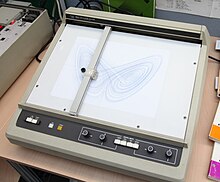

A Cartesian coordinate robot (also called linear robot) is an industrial robot whose three principal axes of control are linear (i.e. they move in a straight line rather than rotate) and are at right angles to each other.[1] The three sliding joints correspond to moving the wrist up-down, in-out, back-forth. Among other advantages, this mechanical arrangement simplifies the robot control arm solution. It has high reliability and precision when operating in three-dimensional space.[2] As a robot coordinate system, it is also effective for horizontal travel and for stacking bins.[3]
- ^ Zhang, Dan; Wei, Bin (2016). Mechatronics and Robotics Engineering for Advanced and Intelligent Manufacturing. Cham: Springer. p. 31. ISBN 978-3-319-33580-3.
- ^ Mingtu, Ma; Yisheng, Zhang (2018). Advanced High Strength Steel And Press Hardening - Proceedings Of The 4th International Conference On Advanced High Strength Steel And Press Hardening (Ichsu2018). Singapore: World Scientific. p. 526. ISBN 978-981-327-797-7.
- ^ Poole, Harry H. (2012). Fundamentals of Robotics Engineering. New York: Van Nostrand Reinhold. p. 35. ISBN 978-94-011-7052-9.